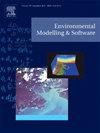基于swaguu耦合模型和云增强模糊综合评价法的城市洪水风险分析
IF 4.8
2区 环境科学与生态学
Q1 COMPUTER SCIENCE, INTERDISCIPLINARY APPLICATIONS
引用次数: 0
摘要
本研究引入了SWAGU模型,该模型通过将SWMM强大的管网建模能力与ANUGA先进的基于非结构化网格的地表流模拟相结合,克服了现有方法的局限性,能够更准确地预测复杂城市环境中的洪水动态。模型的输出被集成到一个增强的云模型框架中。该框架通过引入云模型理论来改进传统的模糊评价方法,以更好地处理专家判断和隶属函数中的不确定性,同时还结合了一种处理极值的新方法。通过对多指标法和单指标法的对比分析,发现多指标法能更全面、客观地评价洪水风险。研究结果表明,与单一指标方法相比,在低风险地区减少了50% - 60%。这项研究强调了将先进的水动力学建模与云增强的多标准评估相结合的优势,可以提供更精确和强大的洪水风险管理框架。本文章由计算机程序翻译,如有差异,请以英文原文为准。
Urban Flood Risk analysis using the SWAGU-coupled model and a cloud-enhanced fuzzy comprehensive evaluation method
This study introduces the SWAGU model, which overcomes limitations of existing approaches by combining SWMM's robust pipe network modeling capabilities with ANUGA's advanced unstructured mesh-based surface flow simulation, enabling more accurate prediction of flood dynamics in complex urban environments. The model's outputs are integrated into an enhanced cloud model framework. This framework improves upon traditional fuzzy evaluation methods by introducing cloud model theory to better handle uncertainty in both expert judgments and membership functions, while also incorporating a novel approach for processing extreme values. A comparative analysis of multi-indicator and single-indicator approaches reveals that the multi-indicator method, offers a more comprehensive and objective evaluation of flood risk. The findings demonstrate a reduction of 50 %–60 % in low-risk areas compared to the single-indicator approach. This study underscores the superiority of integrating advanced hydrodynamic modeling with cloud-enhanced multi-criteria evaluation in providing more precise and robust flood risk management frameworks.
求助全文
通过发布文献求助,成功后即可免费获取论文全文。
去求助
来源期刊

Environmental Modelling & Software
工程技术-工程:环境
CiteScore
9.30
自引率
8.20%
发文量
241
审稿时长
60 days
期刊介绍:
Environmental Modelling & Software publishes contributions, in the form of research articles, reviews and short communications, on recent advances in environmental modelling and/or software. The aim is to improve our capacity to represent, understand, predict or manage the behaviour of environmental systems at all practical scales, and to communicate those improvements to a wide scientific and professional audience.
 求助内容:
求助内容: 应助结果提醒方式:
应助结果提醒方式:


